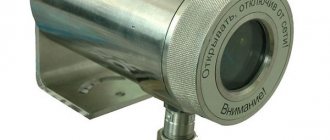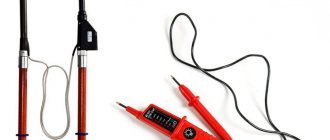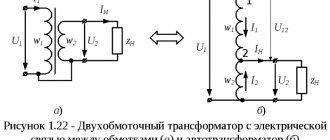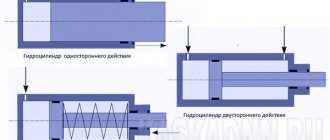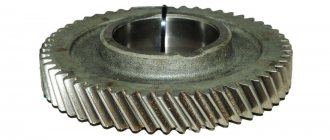Lifts are used to raise vehicles above the floor level during maintenance and can be stationary, mobile or portable.
According to the type of lifting mechanism, lifts are divided into:
- mechanical
- pneumohydraulic
- hydraulic
By type of drive:
- manual
- electric
- powered by car engine
According to the design of the supporting part, lifts are:
- with track frame
- with inter-track frame
- with cross frame
- with support beams
Schematic diagrams of plunger-type hydraulic lifts are shown in the figure.
Types of hydraulic lifts for cars
By type of design, the following types of automotive hydraulic lifts can be distinguished:
- Rack-mounted single-rack
- two-post
- four-post
- single-platform
Let's take a closer look at the operation of these types of lifts.
Hydraulic Post Lift
A lift consists of one or more racks on which movable legs or support platforms are installed. The platforms are lifted directly by hydraulic cylinders, into which hydraulic fluid is supplied from the pumping station. The use of a hydraulic drive ensures smooth lifting and allows you to develop the forces necessary to lift any vehicle.
Depending on the number of posts, there are single-post, two-post and four-post lifts.
Single-post lifts are used during car washing and during anti-corrosion treatment; they can be mobile or permanently installed.
The two-post automobile lift with a hydraulic drive is designed for all types of metalwork work. A hydraulic cylinder is installed in each of the racks. To ensure uniform lifting, the operation of the hydraulic cylinders must be synchronized. Synchronization is provided by hydraulic flow dividers or mechanical devices.
The operation of a four-post lift also needs to be synchronized. Four-post lifts are made with a flat platform for metalworking work, with movable rear platforms.
Benefits of post lifts
- Versatility - providing access to various vehicle components
- High reliability
- High lifting height
Scissor car lift
In this type of lift, one or more hydraulic cylinders operate a scissor linkage mechanism.
Scissor lifts can be mobile or stationary. If necessary, they can be installed in a niche, forming a flat surface with the car service floor.
Depending on the number of supporting platforms, single-platform and double-platform lifts are distinguished.
The manufacturer of lifts, the Forstor company, produces single-platform hydraulic lifts for car service centers and parking lots and double-platform lifts for tire service. You can see the types of lifts, single-platform and double-platform lifts that this company produces, on the company’s official website.
Tire service lift
For tire mounting, two-platform hydraulic lifts are used. The lift is installed under the bottom of the car, providing full access to the car's chassis.
Parking lift
The parking lift is a single platform lift. When folded, the cars are located one behind the other. Using such a lift allows you to save space in warehouses or parking lots.
Scissor lifts
Perhaps the most functional lifting devices today, characterized by maximum ease of operation, small dimensions, good load capacity and low price. In this design, the hydraulic drive drives the lever system, which is shaped like scissors; moving along special grooves towards each other, they thereby straighten and lift the working platform with a load:
- the matter is rarely limited to scissors alone, since they often cannot provide the required lifting height - for example, when storing goods on the upper shelves of shelving structures. Lifts with two, three, four and five scissors are manufactured especially for this purpose, which can operate at significantly higher heights, although with less reliability. As for reliability, there are designs with a parallel arrangement of scissors (for lifting one or even several platforms), the use of which, although not conducive to working at height, provides additional stability and load-carrying capacity of the device;
- Scissor lifts can also be stationary or mobile. Stationary ones are mounted directly into the floor for long-term use in one place - for example, servicing a specific loading and unloading area. Mobile ones - they are also called hydraulic carts - can quickly move around the enterprise, which is especially convenient when there are a large number of work areas or extended storage systems.
Scissor lift
We recommend to buy
More on the topic: Description of the P-97MK “Leader” lift model
Single plunger hydraulic lift
A single-plunger hydraulic lift has a frame 1 mounted on a plunger 2, which extends from a cylinder 3 fixedly installed in the floor of the room; The lifting of the car occurs under the pressure of oil pumped into the cylinder under the plunger. By changing the amount of oil supplied to the cylinder, the lift height can be adjusted.
Rice. Diagrams of plunger-type hydraulic lifts
The specified lift provides the possibility of circular rotation of the car mounted on its frame and is therefore called full-rotary.
Rice. Diagram of a single plunger hydraulic lift
The frame of a single-plunger lift can be tracked or inter-tracked. In the first case, the car rests on the frame with wheels, in the second - with axles, being in a raised state with the wheels hanging out. Track frames are equipped with devices that prevent the vehicle from rolling away.
How to use an inflatable jack
This type of lift is a pneumatic device. In this case, a special pillow is installed under the bottom of the machine, which is subsequently inflated with a special device. To work with such a device you need:
- Place the cushion under the car and spread it evenly.
- Place special mats on top and bottom that are included in the kit. They are designed to avoid pillow punctures.
- Close the lock connecting the valve and hose tightly. This is necessary to avoid air leakage from the pillow.
- Connect the end of the hose to a source of air or gas supply. Special compressors are used.
- The pillow is inflated with air or vehicle exhaust gases.
It is important to monitor the process of inflating the pillow. It should pass evenly in all directions. If any side lags, then it is necessary to check and correct the position of the pillow or lower it and start the process again.
Double plunger lift
A double plunger lift consists of two paired single plunger lifts with or without a common lifting frame. In the latter case, both plungers are equipped with short frames or fork-shaped supports; if there are supports, one of the plungers is made movable. Short frames or a movable plunger provide lifting of vehicles with different bases.
Twin plungers without a common frame can have a synchronous or independent drive. With an independent drive, you can position the vehicle in an inclined position when lifting.
The positive side of frameless double-plunger lifts is the better accessibility of the lower parts of the car, the negative is the impossibility of circular rotation of the car when raised.
The diagram of the hydraulic drive of a single-plunger lift is shown in the figure. Oil from tank 2, through the suction valve with filter 1, is supplied by pump 4, driven by electric motor 3, into cylinder 12 of plunger 11 of the lift. When the pump is running, using handle 9 of control valve 6, oil can be directed into cylinder 12 through bypass valve 8 (during lifting) or directly into tank 2 (idling). Reducing valve 5 (adjusted to a pressure of 9 kg/cm2), at the moment the plunger stops lifting, automatically transfers oil to tank 2. The oil pressure in the system is controlled by pressure gauge 7. Lowering of the plunger 11 occurs under the influence of the weight of the car mounted on the lift frame 10 when the gear is not working pump. In this case, control valve 6 is set to the “descent” position, and the speed of lowering the plunger is regulated by bypassing oil from cylinder 12 to tank 2 (bypassing the pump) using the handle of bypass valve 8.
Spontaneous lowering of a car raised on a lift is prevented by folding racks attached to the lift frame.
For the hydraulic mechanism, spindle oil or a mixture of 65% AK oil and 35% kerosene is used.
Types of structures
Depending on the design features, hydraulic lifts are divided into the following types:
- Console. The design of hydraulic lifts of this type provides for 2 vertically oriented guides along which the loading platform moves, driven by the pressure of hydraulic cylinders. Such models are compact in size. Cantilever hydraulic platforms are capable of lifting over four tons of cargo.
- Scissor type (lift table). Universal models with a platform driven by a drive system. The latter is formed from crossed and interconnected metal slats or beams. Scissor-type devices are distinguished by enviable technical characteristics. These models are capable of lifting loads weighing up to 15 tons to a height of up to 18 meters. Thanks to this feature, scissor-type devices have found application in many areas. But more often, lifts are used in warehouses, production or during construction.
- Telescopic. The loading platform for models of this type rises along vertical posts under the pressure of the working fluid. Telescopic hydraulic lifts are also used in a variety of applications, including service stations and construction sites. These devices are available in different configurations, from compact to powerful models capable of lifting up to 15 tons to a height of 12 meters.
In addition to the above, there are highly specialized types of hydraulic lifts on the market:
- Lifting platforms. These devices are mainly used for lifting and lowering heavy and bulky cargo. Lifting racks are mainly used in warehouse, industrial or retail facilities.
- Low profile lift tables. When fully lowered, the platforms of these devices form a flat surface with the floor. This feature makes loading heavy items easier.
- Inclined hydraulic lifts. One of the types of overpasses, which is used for driving cars onto various hills. Also, models of this type can be used to adjust the angle of inclination of the working platform, tilting heavy loads, moving carts and other purposes.
Electromechanical lift
The group of electromechanical lifts includes:
- stationary screw four-post lift for trucks and buses
- two post lift for passenger cars
Rice. Electromechanical four-post lift GARO model 448
In a four-post lift, inside the posts 8 there are screws 4, on which the lifting frame 5 is suspended using nuts 3. Each screw is driven by an independent electric motor 1 through a worm gearbox 2.
To hang the car wheels, a lifting trolley 6 with jacks 7 is used. The lift frame is raised and lowered by four synchronous electric motors with reversible magnetic starters. The lift's lifting capacity is 7 tons; the total power of electric motors is 11.2 kW.
Rice. Electromechanical two post lift
How to make a reliable car lift with your own hands
It is not easy to make a car lift from a jack yourself, and therefore you need to read the instructions in advance.
Calculation of dimensions and creation of a drawing
First you need to decide on the size of the equipment for working with cars.
The choice of car lift dimensions depends on the size of the garage in which it will be used. The average height of the device is three and a half meters, and the width is three meters. Equipment with such dimensions is capable of lifting a vehicle whose weight reaches 3-4 tons.
Required Components and Tools
Having decided on the dimensions of the car lift, you can begin to prepare the necessary tools and materials. To work you will need:
- welding machine for joining iron components;
- drill;
- drill;
- tape measure for measuring the dimensions of device parts.
The materials from which the device is made include:
- bedding corners eight centimeters wide;
- iron plates, the thickness of which should be 1-2 centimeters;
- worm gearbox.
Assembly instructions
At the initial stage of creating a lift, steel corners are installed in the walls of the garage pit. After this, a metal plate is installed on their shelves and attached to the surface. The gearbox is installed on top, after which a key is fixed on the drive shaft.
After installing the gearbox, holes are made on the surface of the plate through which the chain will pass. When the chain is installed, a sprocket is put on the shaft. To install the second chain, the same holes are made on the opposite side of the plate.
The resulting structure can withstand a load of 2-3 tons.
Electromechanical lift-tilter
The electromechanical lift-tipper shown in the figure allows you to tilt the car at various angles, but not more than 60°.
Rice. Electromechanical tipper: 1 - stand; 2 — lifting frame; 3 — car fastening clamp; 4 - carriage; 5 - fixed frame
The lifting frame is driven by an electric motor with a worm gear and a screw with a nut located in the rack. When using a tipper, you must first remove the battery from the vehicle and seal the holes in the master brake cylinder and the neck of the engine crankcase and fuel tank.
How to use a jack: general operating rules
Like any other technical device, the jack requires compliance with safety precautions during operation. Its use is not difficult, the main thing is to know where to put the jack and what to do with it next. This is far from a new device; most samples have been tested by time and personal experience.
Classic rack and pinion jack
Driver's courses do not teach how to properly use and install this device. You need to study everything yourself. In addition, most people, not knowing clear rules, believe that with its help you can not only lift and lower a load, but also hold it for a long time. To avoid possible health risks, you need to learn how to install a jack correctly.
A specially developed list of rules can help with this:
- The vehicle must only be placed on a level surface. There should not be any slopes or other irregularities. The machine must be parked in such a way that there is no likelihood that it will move.
- All wheels must be locked very securely. Bricks, wooden wedges, stones or any other objects are suitable for this.
- The car should rise and fall very smoothly, without sudden movements or jerks.
- It is important to clearly know where to place the jack correctly. To lift the car on the bottom there are special mounts for the jack hook. Under no circumstances should you attach it to the front or rear bumper, or to any other parts of the car that are not intended for this purpose.
- It is necessary to engage reverse or forward gear, put the car on the handbrake and block the wheels on the opposite side from the side being lifted.
- It is necessary to use a support because the jack can only lift loads, but not hold them. A do-it-yourself jack stand is suitable, but it is important that it is made of wood, iron or any other material other than brick or other unreliable material.
- Before lowering yourself under the car, it is important to check the security of the machine and the device several times. To do this, you can simply rock the car in different directions.
- After completing the work, you need to know how to lower the jack along with the car. The same rules apply here - no sudden movements, smoothness.
Hydraulic lift - types, principle of operation and price
A hydraulic lift is a device that is found in almost every service station and car service center. Thanks to the use of this installation, you can quickly and efficiently perform vehicle maintenance work. However, in addition to this, there is a hydraulic lift used for municipal purposes and in construction. Most often, it is placed on a car chassis and lifts from 2 to 5 people (depending on the type and design of the device). You can find out exactly what hydraulic lifts are and how they are designed in the article below.
Post lifts
Most often they are used in services, service stations and vehicle fleets, as well as in automobile manufacturing plants and passenger vehicle warehouses. The lift device includes the working platform itself, onto which the equipment is driven, a vertical or inclined metal stand/racks along which the platform moves, a drive system that carries out the lift, as well as safety devices that block the platform in case of emergency situations. The main parameter by which these lifts differ from each other is the number of racks:
- single-post lifts are used to work with light loads and are most often manufactured in a mobile version. They can also be used as auxiliary lifting platforms when lifting heavy equipment with another lift;
- two-post lifts are the most widespread due to their reliability, high parameters, medium dimensions and affordable price. Accordingly, here the platform moves along two racks, which, for additional reliability, are connected to each other by a crossbar (this crossbar can also be used when laying hoses for supplying hydraulic oil - in order to save work space and reduce the risk of damage to the hose when equipment drives onto the platform) ;
- Four-post lifts are used to service heavier passenger cars and light trucks, as they are distinguished by their enormous load capacity, the presence of additional locking systems and overall high performance. It can come in various configurations to facilitate easier entry of equipment onto the platform from several sides, and be equipped with additional platforms, turntables, cargo crossbars, etc. The main disadvantage of this type of equipment can be considered its very impressive dimensions and equally impressive price.
YouTube responded with an error: The request cannot be completed because you have exceeded your quota.
Four-post devices
This hydraulic lift is also used in the automotive service industry. However, if the first type is most often used to lift passenger cars, then the four-post mechanism, due to its increased efficiency and load capacity, is used to lift long-wheelbase vehicles, trucks, buses and heavy jeeps. Despite its excellent technical characteristics, the four-post hydraulic lift also has disadvantages, mainly related to size and cost, which does not allow its use in all car repair shops today.
How to Use a Rack and Screw Jack
When using rack and screw jacks, the above rules and recommendations, plus some specific ones, apply.
Screw device
Rack and pinion devices, like screw devices, have become widespread due to their simplicity of design. They are mainly popular among off-road enthusiasts. The design of such devices allows you to lift a lot of weight, which plays a decisive role. They can be used in any conditions due to their unpretentiousness and small dimensions, which is an advantage compared to hydraulic lifts, which are massive and take up a lot of space in the trunk.
Safety precautions when working with rack and pinion devices:
- Install the lift at an angle so that it does not rest against the hood.
- Place the jack perpendicular to the surface of the support.
- Check fixation and tightness.
- Press the switch firmly with your whole hand, since it moves tightly.
Double post
These devices can be seen at car service stations. The two-post hydraulic lift combines such qualities as low price, high performance, reliability and low maintenance. In addition, this device is characterized by an extensive range of functions.
The main mechanism in the operation of this lift is a hydraulic cylinder, which is most often mounted in one of the racks and driven by an electric motor. However, that's not all. More expensive options are equipped with several cylinders installed in each rack. This design has an increased load capacity, and all units that are used when lifting a load are very reliable and productive.
Advantages of hydraulic lifts
The main advantage of this lifting equipment is its maximum noiselessness, which is ensured by the presence of a noise absorption system. Other advantages of hydraulic lifts include smooth operation, the ability to stop precisely on the required floor, operation during a sudden power outage (the cabin will be returned to the first floor), and the absence of the need to use a shaft and a 3-phase power system. In addition, the operation of hydraulic lifts does not require the use of a machine room.
